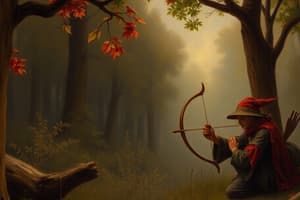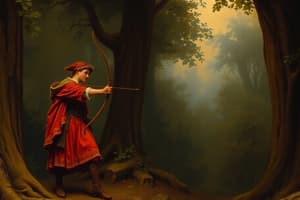Podcast
Questions and Answers
Who is known for writing the epic tale of Beowulf?
Who is known for writing the epic tale of Beowulf?
- John Keats
- Percy Bysshe Shelley
- William Wordsworth
- Unknown (correct)
Which Romantic poet highlighted nature elements like trees in their odes?
Which Romantic poet highlighted nature elements like trees in their odes?
- Charlotte Bronte
- John Keats (correct)
- William Wordsworth
- Charles Dickens
What does Wordsworth encounter in Tintern Abbey that revitalizes his spirit?
What does Wordsworth encounter in Tintern Abbey that revitalizes his spirit?
- Palm Tree
- Oak Tree
- Fir Tree
- Wild Cherry Tree (correct)
Which author from the Victorian period explored themes of love and self-discovery in Jane Eyre?
Which author from the Victorian period explored themes of love and self-discovery in Jane Eyre?
In what period did English literature flourish with the Romantic era's focus on nature and emotion?
In what period did English literature flourish with the Romantic era's focus on nature and emotion?
Which literary movement saw postmodern authors experimenting with narrative techniques and blending genres?
Which literary movement saw postmodern authors experimenting with narrative techniques and blending genres?
What symbolic meanings are associated with the evergreen fir tree in English literature?
What symbolic meanings are associated with the evergreen fir tree in English literature?
In medieval mythology, what did the World Ash Yggdrasil represent?
In medieval mythology, what did the World Ash Yggdrasil represent?
How did Shakespeare use the evergreen fir tree in his plays?
How did Shakespeare use the evergreen fir tree in his plays?
What tradition did the Victorians establish involving the fir tree during Christmas?
What tradition did the Victorians establish involving the fir tree during Christmas?
Which Pulitzer Prize-winning book features a central scene set among ponderosa pine trees?
Which Pulitzer Prize-winning book features a central scene set among ponderosa pine trees?
What is the fir tree mostly considered as in English literature?
What is the fir tree mostly considered as in English literature?
Flashcards are hidden until you start studying
Study Notes
English Language: Exploring Literature and Folklore through the Fir Tree
The English language is a vast and intricate tapestry woven from countless threads of history, culture, and tradition. In this journey through its depths, we'll delve into two captivating strands: the world of English literature and the fascinating folkloric symbolism around the fir tree.
English Literature
With roots tracing back over a thousand years, the foundations of modern English literature lie in Old English poetry and prose. From the epic tales of Beowulf to the poignant wisdom expressed in the riddles of the Exeter Book, these early works have left their indelible mark on literary development.
As time progressed, English literature flourished with the Romantic era's emphasis on nature and emotion. Poets such as William Wordsworth, Percy Bysshe Shelley, and John Keats highlighted natural elements like trees within their odes. For example, Wordsworth's Tintern Abbey describes how a simple encounter with a wild cherry tree revitalizes his spirit.
In the Victorian period, Charles Dickens' classic novels illustrated how societal issues intertwined with characters' journeys while Charlotte Bronte's Jane Eyre explored themes of love and self-discovery against the backdrop of Yorkshire moors. Postmodern authors continued this trend by experimenting with narrative techniques and amalgamating genres. Toni Morrison, for instance, combined magic realism and social commentary in her novel Beloved, which examines slavery's lasting impact on African American communities.
The Symbolic Fir Tree
Natural motifs throughout English literature often embody deeper meanings beyond their physical forms. One particularly prominent element is the evergreen fir tree. Its enduring green needles served as symbols of life, hope, renewal, and constancy across various texts.
Medieval mythology portrayed Yggdrasil, the World Ash, as the cosmic axis connecting nine worlds together under one massive umbrella-like bough. Likewise, Norse Christians interpreted this as the Holy Cross, infusing it with religious significance. Shakespearean plays also employed the image of the evergreen. Hamlet's soliloquy refers to himself as "a true plant" remaining verdure amidst autumn's decay - thus indicating spiritual resilience.
Moreover, the Victorians celebrated Christmas by decorating a pine or spruce tree (often mistletoe), emphasizing comfort during harsh winter nights. This tradition developed into today's festive custom of trimming a fir tree with lights and ornaments, further underscoring the tree's role as a cultural icon. Modern fiction still pays homage to the fir tree as a focal point of narratives; Cormac McCarthy's Pulitzer Prize-winning book, No Country for Old Men, features a central scene set among ponderosa pine trees, enhancing its suspenseful atmosphere.
Throughout centuries of evolution, English literature has mirrored society, reflecting changing values and traditions while cultivating new expressions of artistry. And in each incarnation, the majestic fir tree remains entrenched as a ubiquitous symbol linking humanity to our shared experience of beauty and perseverance.
Studying That Suits You
Use AI to generate personalized quizzes and flashcards to suit your learning preferences.



